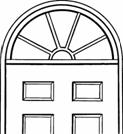Charles Brooking is a fascinating and knowledgeable collector of architectural detail, The Brooking Collection of Architectural Detail, and as Surveyors we find his lifelong quest to collect British building details unique, informative and valuable and a collection that must be kept intact for years to come. If you need help and advice with regard to building surveys, structural surveys, structural reports, engineers reports, specific defects report, dilapidations or any other property matters please free phone 0800 298 5424.
The following is one of a series of interviews with Charles Brooking, Historic and Listed Buildings Detail Expert, The Brooking Collection of Architectural Detail and a Surveyor where we have recorded his comments and various aspects that have affected windows and doors and other collectibles. The interviews outline how his collection started and built over the years and gives an insight into the amazing architectural features housed in his fine collection.
Surveyor: Was Westbourne Terrace, Paddington another area you choose to rescue architectural detailing?
Charles Brooking: Yes, Westbourne Terrace, I visited one of the houses there in 1975. Westbourne Terrace was built in the 1840's in a sort of classical style stucco set of terraces.
I also rescued items in Cleveland Gardens and Gloucester Terrace which were again 1840's, with items such as covered windows, architraves, staircase banisters and fire grates dating from the 1840's to 1890's.

Rescue defined
Charles Brooking defines a rescue as saving a window or door or staircase that would be doomed.
Charles Brooking was a pioneer in the rescue of architectural detailing as many years ago it was very much considered a strange and an unusual past time to want to rescue old parts of buildings with everything new and shiny being so important.
There were examples of glazing bars and smaller sash windows/sash pulleys. In the case of Westbourne Terrace I rescued some interesting 1840's fire grates, sash pulleys, door furniture, architrave sections typical of the newer classical style, I suppose they were almost Greek revival fittings.
In Sussex Gardens in 1978 I had rescued some lovely margin light windows with very thin amber margins, which were 1830's.
In around 1976-77 in St Michaels Street, Paddington I found a very interesting lead fanlight consisting of circles.
Surveyor: Where would you typically find a fanlight?
Charles Brooking: It's really a fan, an arched opening or square opening above a glazed window above a door to light the hall.
Surveyor: Does this tend to be at an entrance door?

Charles Brooking : Entrance door, yes exactly. You can get them over internal doors but generally entrance doors and they were decorated in various ways with radiating glazing bars in various patterns, lead developing from the 1780's onwards with the patterns Underwood and Bottomley.
There's a very good book by John Sambrook on fanlights. He worked for the Greater London Council Historic Buildings Division.

Surveyor: About what year would that be?
Charles Brooking: I suppose it would be the late 1980's when he wrote the book. He used many of my examples in the book and he was quite a friend, who found fanlights interesting, as they were simple, almost artisan and a bit just restrained with it just showing how elegant the simple things were.
Surveyor: Are there problems removing fanlights?

Charles Brooking: Well, it's quite difficult because they are built in, often behind an arch and plastered in. If the building is coming down it is not a problem, you have to break away all of the lath and plaster and cut it out. If it's being kept there is an issue to get them out whole - it's not easy.
Surveyor: How are fanlights fixed in place?
Charles Brooking: The lath and plaster.
Surveyor: Is that what holds them in place?
Charles Brooking: Sometimes internally yes. Sometimes they are partly built in and fanlights do vary and often get rot in the frame because there seems to be a problem with water penetration around that area for some reason. A lot of them I find have rotted.
Surveyor: This is so the water coming in above the front door?

Charles Brooking: Yes, and it seems to rot the frame. On many occasions this has been an issue but often they had grooves on the inside where the lath's actually butt up against them.
Surveyor: Do you think it's in poor quality timber?
Charles Brooking: I think it's just water penetration from possibly from above where you had a balcony perhaps water is getting in and seeping down from the edge of the balcony above the window. That's probably the cause in many cases.
Surveyor: What sort of timber are they normally made out of?

Charles Brooking: Baltic Pine in sections pegged together, very simple frames and the fanlight is built up inside that.
Surveyor: Using what sort of glass?
Charles Brooking: Again it was Crown glass, or sometimes coloured glass or plate glass in better quality examples. I managed to recover a lot of fanlights at that time, very good examples from Gordon Square, Euston by Thomas Cusack from a very fine example of his houses there.
If you found this article on The Brooking Collection of Architectural Detail interesting you may also be interested in the following articles on our website:
Major rescue at the Leadenhall Street, London EC3
Major rescue from Firestone Factory, Great West Road, London
Late 1970s Charles Brooking Goes Full Time
Repairing Cracks
Rising damp, or is it?
Damp walls
References:
TheBrookingCollection.com
DartfordArchive.org.uk
IHBC.org.uk
ProjectBook.co.uk
Independent Surveyors
If you truly do want an independent expert opinion from a surveyor with regard to building surveys, structural surveys, structural reports, engineers reports, specific defects report, dilapidations or any other property matters please contact 0800 298 5424 for a surveyor to give you a call back.
Commercial Property Surveyors
If you have a commercial property, be it leasehold or freehold, then you may wish to look at our Dilapidations Website at www.DilapsHelp.com and for Disputes go to our Disputes Help site www.DisputesHelp.com.
We hope you found the article of use and if you have any experiences that you feel should be added to this article that would benefit others, or you feel that some of the information that we have put is wrong then please do not hesitate to contact us (we are only human).
The contents of the website are for general information only and is not intended to be relied upon for specific or general decisions. Appropriate independent professional advice should be paid for before making such a decision.
All rights are reserved the contents of the website are not to be reproduced or transmitted in any form in whole or part without the express written permission of buildingsurveyquote.co.uk
